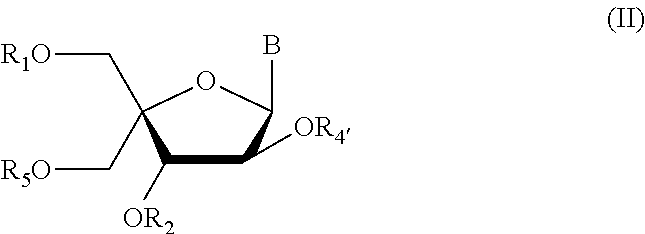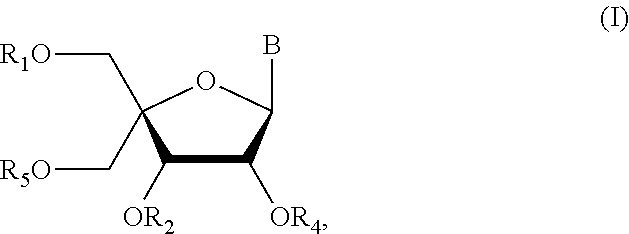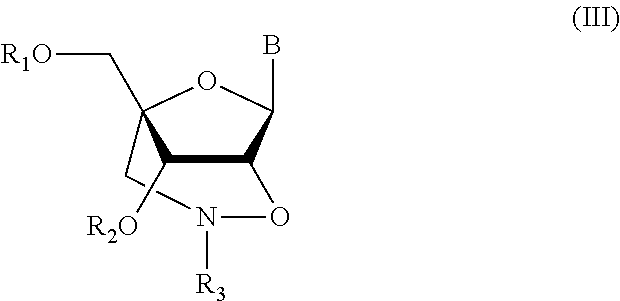Method for synthesizing nucleic acid
a nucleoside and intermediate compound technology, applied in the field of nucleic acid synthesis method and intermediate compound there, can solve the problems of insufficient oxidizing protection under oxidizing conditions, inability to obtain uniform products, and inability to efficiently and conveniently deprotect the body, so as to achieve efficient and convenient production of nc-type nucleosides, high yield, and high yield
- Summary
- Abstract
- Description
- Claims
- Application Information
AI Technical Summary
Benefits of technology
Problems solved by technology
Method used
Image
Examples
example 1
Synthesis of p-toluenesulfonylated compound (step a′)
[0514]Using compound 6a′ obtained in the same manner as in Example 3 of WO2007 / 090071 as a starting material, compound 6a′ (15 mmol, 9.0 g), tosyl chloride (30 mmol, 5.7 g) and 4-dimethylaminopyridine (15 mmol, 1.8 g) were dissolved in pyridine (100 mL), and the reaction mixture was stirred at 80° C. for 15 hr. The reaction was quenched by adding ice to the reaction mixture, and the reaction mixture was concentrated under reduced pressure. The obtained syrup-like residue was diluted with ethyl acetate, and the organic layer was washed with water (twice) and saturated brine. The combined aqueous layer was extracted with ethyl acetate, and the organic layers were combined and dried over sodium sulfate. Sodium sulfate was filtered off, the filtrate was concentrated and the obtained residue was purified by moderate-pressure silica gel column chromatography (hexane / ethyl acetate, 15-+35%) to give compound 7′ (p-toluenesulfonylated comp...
example 2
Synthesis of Glycosylated Compound (Steps b′, c′)
[0517]Compound 7′ (13.7 mmol, 10.3 g) and acetic anhydride (7.9 mL) were dissolved in acetic acid (31.7 mL), conc. sulfuric acid (15.8 μL) was added, and the reaction mixture was stirred at room temperature for 2 hr. To the reaction mixture was added ice-cooled about 1N aqueous sodium hydroxide solution (about 20 ml), and the reaction mixture was vigorously stirred for several minutes. The reaction mixture was diluted with ethyl acetate, and the organic layer was washed with 0.5N aqueous sodium hydroxide solution, water and saturated brine in this order. The aqueous layer was collected, and extracted again with ethyl acetate. The combined organic layer was neutralized with sodium bicarbonate and dried with sodium sulfate. Sodium bicarbonate and sodium sulfate were filtered off, and the filtrate was washed with water and brine in this order to remove the remaining salt. The organic layer was dried over sodium sulfate, and sodium sulfat...
example 3
Synthesis of acetyl-deprotected compound (step d′)
[0520]Compound 9′ (12.8 mmol, 12.5 g) was dissolved in methanol (192 ml), ammonia (96 mL as about 7M methanol solution) was added, and the reaction mixture was kept at room temperature for 2 hr. The ammonia and solvent were evaporated under reduced pressure, and the obtained residue was purified by moderate-pressure silica gel column chromatography (hexane / ethyl acetate, 70→90→100%) to give compound 10′ (acetyl-deprotected form, 10.1 g, 85%) as a white foam.
[0521]1H NMR (CDCl3, 300 MHz) δ 8.92 (br s, 1H, exchangeable with D2O), 8.55 (s, 1H), 8.00 (d, 2H, J=7.0 Hz), 7.92 (s, 1H), 7.87-7.80 (m, 3H), 7.76-7.70 (m, 3H), 7.61-7.31 (m, 15H), 7.23 (d, 1H, J=7.6 Hz), 7.15 (d, 2H, J=8.1 Hz), 5.82 (d, 1H, J=4.9 Hz), 4.90 (d, 1H, J=11.6 Hz), 4.83 (d, 1H, J=11.6 Hz), 4.80 (ddd, 1H, overlapped), 4.62 (d, 1H, J=5.9 Hz), 4.46 (d, 1H, J=10.5 Hz), 4.41 (d, 1H, J=10.5 Hz), 3.80 (d, 1H, J=6.8 Hz, exchangeable with D2O), 3.76 (d, 1H, J=10.8 Hz), 3.71 (d...
PUM
| Property | Measurement | Unit |
|---|---|---|
| Temperature | aaaaa | aaaaa |
| Acidity | aaaaa | aaaaa |
| Fluorescence | aaaaa | aaaaa |
Abstract
Description
Claims
Application Information
 Login to View More
Login to View More - R&D
- Intellectual Property
- Life Sciences
- Materials
- Tech Scout
- Unparalleled Data Quality
- Higher Quality Content
- 60% Fewer Hallucinations
Browse by: Latest US Patents, China's latest patents, Technical Efficacy Thesaurus, Application Domain, Technology Topic, Popular Technical Reports.
© 2025 PatSnap. All rights reserved.Legal|Privacy policy|Modern Slavery Act Transparency Statement|Sitemap|About US| Contact US: help@patsnap.com



